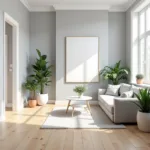Purple, a rich and regal color, holds a unique position on the color wheel. But what is its opposite, its complementary color? Understanding color relationships is essential for creating harmonious and visually appealing designs, whether you’re painting a room, choosing an outfit, or creating a piece of art. The opposite of purple on the color wheel is yellow. This vibrant hue offers a striking contrast and can be used in various ways to enhance purple or stand alone as a powerful statement.
Understanding the Color Wheel and Complementary Colors
The color wheel, a visual representation of colors arranged according to their chromatic relationships, is a fundamental tool for artists and designers. It helps us understand how colors interact and how to create pleasing color combinations. Complementary colors sit directly opposite each other on the wheel. They offer the highest degree of contrast and can create a vibrant and energetic effect when used together.
What color goes with mauve pants, you ask? Understanding color theory, particularly complementary colors, will greatly assist you. You can find more information on what color goes with mauve pants.
Yellow: The Vibrant Counterpart to Purple
Yellow, a color often associated with sunshine, happiness, and optimism, provides a perfect balance to the cool and mysterious nature of purple. Imagine a field of purple lavender under a bright yellow sun – the contrast is both striking and harmonious. This interplay of warm and cool tones creates a dynamic visual experience.
Different Shades of Purple and Their Complements
While the general opposite of purple is yellow, the specific shade of yellow can vary depending on the shade of purple. For example, a light lavender will have a lighter, more pastel yellow as its complement, while a deep violet will pair well with a richer, more golden yellow.
You might also be interested in learning how to pick paint colors for your home. Understanding complementary colors is a great foundation for choosing a cohesive and visually appealing palette.
Using Purple and Yellow in Design
The combination of purple and yellow can be used to create a variety of effects in different design contexts.
- High Contrast: Use pure, saturated versions of purple and yellow for a bold and energetic look.
- Subtle Harmony: Pair lighter tints and shades of these colors for a more calming and sophisticated feel.
- Accent Colors: Use one color as the dominant shade and the other as an accent to add pops of vibrancy.
“Understanding the interplay of complementary colors like purple and yellow is essential for any designer,” says renowned color expert, Amelia Chromatica. “These contrasting hues can create a dynamic tension that adds depth and visual interest to any project.”
You can learn more about the nuances of the color wheel and its applications at what is opposite purple on the color wheel.
Conclusion
The opposite of purple on the color wheel is yellow. This dynamic duo offers a range of design possibilities, from bold contrasts to subtle harmonies. By understanding the relationship between these complementary colors, you can create visually stunning and engaging designs that capture attention and evoke emotion. Knowing what is the opposite of purple on the color wheel empowers you to make informed color choices that bring your creative vision to life.
FAQ
- What is a complementary color scheme?
- What other colors go well with purple?
- How can I use purple and yellow in my home decor?
- Are there any cultural associations with purple and yellow?
- Where can I find more information on color theory?
- How can I learn how to use green color corrector?
- What colors harmonize with my green eyes? Learn more about what colors look good on green eyes.
For further assistance, please contact us at Phone Number: 0373298888, Email: [email protected] Or visit us at 86 Cau Giay, Hanoi. We have a 24/7 customer service team.
